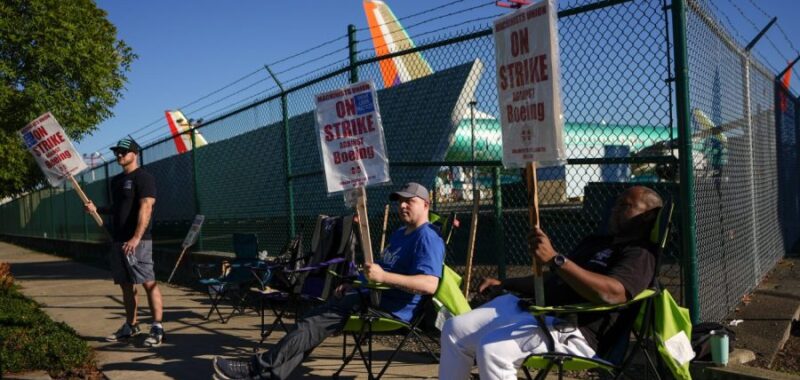
Four Democratic lawmakers from the state of Washington this week urged Boeing and the union representing striking machinists around Seattle and Portland to resolve the labor dispute.
Around 33,000 machinists walked off the job shortly after midnight on Sept. 13, the first time the International Association of Machinists and Aerospace Workers (IAM) has been on strike since 2008.
Sens. Maria Cantwell and Patty Murray and Reps. Adam Smith and Rick Larsen called on the two sides to “expeditiously work out a fair and durable deal that recognizes the importance of the machinist workforce to Boeing’s future.”
“With the machinist strike now lasting well over a month, and with no further talks currently scheduled, we urge you to redouble your efforts to reach a mutually beneficial resolution,” the lawmakers wrote in a letter to Boeing President and CEO Kelly Ortberg, IAM 751 President Jon Holden and IAM District W24 President Brandon Bryant Tuesday.
Members overwhelmingly rejected a tentative agreement that had included a 25 percent wage increase over the next four years, and have demanded the reinstatement of pensions.
Negotiations broke down earlier this month, and an IAM spokesperson told The Hill Wednesday that no dates have been set for the two sides to return to the negotiating table.
A Boeing spokesperson told The Hill that the company remains “committed to finding a resolution to end the strike.”
“We will work with the union when they are ready to bargain an agreement that recognizes our employees and preserves our company’s future,” the spokesperson said.
At a strike rally Tuesday at the Seattle Union Hall, Holden vowed the union would not “walk away” from the fight.
“Some have said that we should get up and walk away. I care too much about this membership to walk away. The IAM will never walk away. We will do what it takes to get a fair agreement,” Holden said.
Acting Labor Secretary met separately with IAM 751 and Boeing leadership Monday to urge both sides to continue the bargaining process. Cantwell and Rep. Pramila Jayapal (D-Wash.), who represents Seattle, visited the picket line Tuesday.
The strike has drawn a national spotlight and attention as it drags on, and IAM International President Brian Bryant said Friday that the union appreciated the “the strong ongoing support” it has received from members of Congress.
“A growing number of elected officials have recognized that given the history of excessive CEO compensation at Boeing, company executives should be able to return to the negotiating table, and do right by their workers who have made incredible sacrifices to keep the company afloat,” Bryant said.
Last week, Jayapal led a letter signed by members of the Congressional Progressive Caucus including Reps. Alexandria Ocasio-Cortez (D-N.Y.), Rashida Tlaib (D-Mich.) and Ro Khanna (D-Calif.) urging both sides to “bargain in good faith to reach a fair contract in a timely manner.”
“We have heard from our constituents that many of the currently striking Boeing workers are experiencing financial distress, and it is deeply concerning that as of October 1, 2024, striking workers have lost their employer-provided health benefits for exercising their right to strike,” the letter said.
Neil Bradley, executive vice president and chief policy officer at the U.S. Chamber of Commerce, said in a statement Wednesday that “it is unfortunate that some elected officials are irresponsibly inflaming tensions, rather than helping restore jobs for their constituents.”
The strike has already cost the company and workers $5 billion, according to the latest analysis by Anderson Economic Group. Boeing announced last Friday that it would be laying off 10 percent of its workforce, or around 17,000 employees, in the coming months and delay delivery of its 777X planes until 2026.
Ortberg said in an email last Friday that the “business is in a difficult position, and it is hard to overstate the challenges we face together.”
“Beyond navigating our current environment, restoring our company requires tough decisions and we will have to make structural changes to ensure we can stay competitive and deliver for our customers over the long term,” he added.

